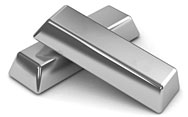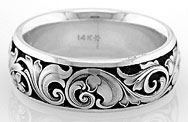Sterling Silver - Christmas Gift
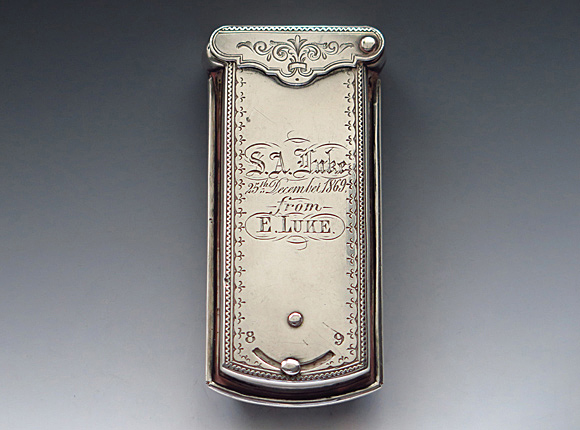
Needle Case
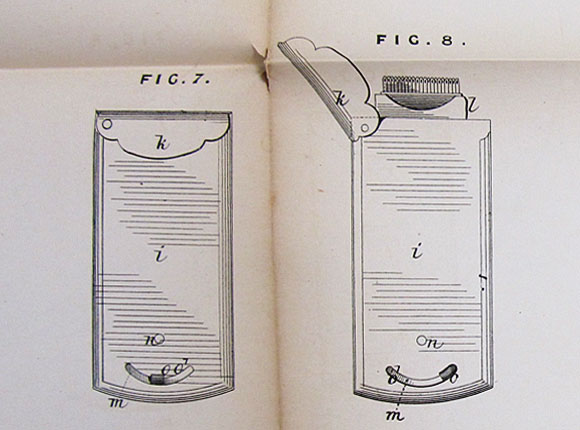
UK Patent 1868-3517 drawing
Design Details
Needle Case Type: |
Quadruple |
Patent/Registered to: |
William Avery, Redditch Needle Manufacturer and Albert Fenton of the same place, Machinist |
Patent/Design Representation #: |
Mechanical Patent: #3517 |
Patent/Design Registration Date: |
November 19, 1868 |
Location of Patent/Design Registration: |
British Library - Business and Intellectual Property Centre – London |
Reference #: |
1868-3517, Figures 7-10 |
Dimensions: |
3.3 x 7 |
Material: |
Silver |
Name Variations: |
from E. Luke |
Other Variations: |
See other Quadruples |
US Patent |
Additional Photographs
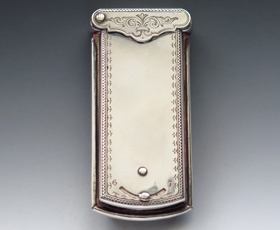
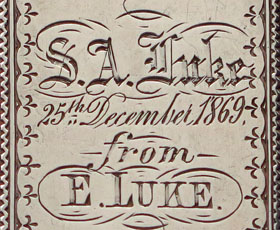
Back and detailed view of the engraving
And Who Were the Luke's?
What makes this Quadruple needle case unique is the front which is engraved with three lines and the words “S. A. Luke 25 December 1869 from E. Luke”. I have always wondered about the people who originally owned the Avery needle cases in my collection. Who were they and what were their lives like? This got me to thinking, perhaps if I did a little research, maybe I could find out who S. A. Luke and E. Luke were which would make this needle case extra special. I soon discovered there was only one Luke family in the UK in the 1871 census that included individuals with the initials E. Luke and S. A. Luke. Additionally, because this Mr. Luke worked as a London drapers warehouseman, the occupation of many of the individuals who sold Avery needle cases in the London area, I felt confident this was the correct family. During the Victorian Era a drapers warehouseman was someone who worked in a warehouse that sold cloth, fabrics and sewing items. After further research I discovered Mr. Luke’s wife was born on Christmas day which matched the day and month engraved on the needle case. Let me share with the you the story I now tell about the needle case I named the Quadruple: Sterling Silver - Christmas Gift.
Edwin Luke was born in 1839 in Walworth, a district of south London. He was the son of Abraham North Luke, a grocer and Sarah Luke (nee Gunn). Edwin had 6 siblings: 5 sisters and an older brother. During his childhood his family lived at first in the Lambeth section of south London, later moving to the town of Romford in northeast London. By 1861 they moved again, this time to Westow Street in Upper Norwood, an area of south London not far from where the Crystal Palace was moved to after the Great Exhibition of 1851. His father died there in 1872 and his mother in 1877 and both were buried at the West Norwood Cemetery. By the time Edwin was 21 he was living at 12 Warwick Square in London which was half a mile south of Buckingham Palace and was working as a commercial clerk. The fact that he was living at a place with 65 other young men, most in their late teens or early twenties who were all commercial clerks, implies he was either living in a housing project of some type or more likely living and working in a factory or warehouse.
Sarah Ann Strange was born on December 25, 1836 and was baptized at a church a couple blocks northwest of St. Paul’s cathedral in London. Her parents were William Strange, a bookseller, and Ann Strange, who from 1835 until at least 1841 lived on Paternoster Row next to St. Paul’s. By 1861 her father was listed as a bookseller employing 4 boys although he was occasionally listed as a publisher. Sarah Ann had 4 brothers and 2 sisters, she being the oldest daughter. For many years the Strange family lived in the London Borough of Hackney, located in northeast London.
How Edwin and Sarah Ann met is still a mystery. In 1868 Edwin Luke and Sarah Ann Strange were united in marriage at the Horbury Chapel on Notting Hill in the Kensington district just west of central London. At the time of their marriage Edwin was working as a warehouseman. As a birthday and Christmas gift in 1869 Edwin purchased a Quadruple needle case made of silver that he had engraved for his wife. The couple lived at 31 Vaughan Road in the Brixton district of south London where Edwin worked as a drapery warehouseman from at least 1871 until at least 1901. They had 3 children of which 2 survived to adulthood: William who was born in 1872 and died 7 weeks later of gastritis, Herbert who was born in 1874 and Percy born in 1876. Sometime after Edwin retired the family moved to Swanley Village in Kent, about 24 miles south of London, where they spent the remainder of their lives. For many years two of Sarah’s younger sisters, who never married, lived with the Luke family. Since neither sister was employed, they either lived on money inherited from their Strange parents or the Luke family had the funds necessary to support them. Edwin’s degree of success was confirmed in the marriage records of his son's which indicate Edwin had attained the status of gentleman by 1908 and as Esquire by 1918. Sarah Ann Luke died in 1928 at age 91 followed by Edwin two years later in 1930 at age 90. After her death, Sarah Ann’s estate, valued as £27, 8s, 5d pence, which is equivalent to £1255 today (approximately $1,742), was left to her son Percy Unfortunately, no record of Edwin’s estate has been found. Their son Herbert became an architect and Percy was a merchant and later an export textile agent.
Click here to see the Luke geneaology source details.





